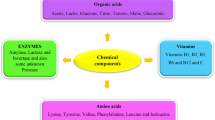Abstract
The effect of black/bitter cumin seeds Centratherum anthelminticum (L.) Kuntze extract (CA) containing mixture of polyphenolic compounds was tested on rat intestinal α-glucosidases, human salivary α-amylase activity and postprandial hyperglycemia in rats. Polyphenolic components of C. anthelminticum seeds (CA) dose dependently inhibited rat intestinal disaccharidases. IC50 values were found to be 34.1 ± 3.8, 62.2 ± 4.5 and 500.5 ± 11.9 μg of CA for rat intestinal sucrase, maltase and p-nitrophenyl α-d-glucopyranoside (PNP-glycoside), respectively. CA also inhibited human salivary α-amylase activity with IC50 value of 185.5 ± 4.9 μg. The inhibitory effect of CA was found to be 8–32 fold more potent than dl-catechin but less effective than acarbose on rat intestinal disaccharidases and salivary α-amylase. The enzyme kinetic studies showed a non-competitive type of inhibition with a low K i value of 30.24 μg, 76.67 μg and 341.60 μg of CA for maltase, sucrase and PNP-glycoside hydrolysis activities, respectively. The in vitro inhibition of glucosidases was further confirmed by in vivo maltose tolerance test in rats. Feeding of CA at 50–200 mg/kg body weight (b.wt) to maltose (2.0 g/kg b.wt), loaded rats significantly reduced the postprandial plasma glucose levels compared with acarbose. The inhibitory components of CA were identified as a mixture of polyphenolic compounds viz., gallic acid, protocatechuic acid, caffeic acid, ellagic acid, ferulic acid, quercetin and kaempferol. This study demonstrated that CA exerts antihyperglycemic effect by decreasing postprandial glucose in rats by modulating α- amylase and glucosidases (sucrase and maltase) activity and thus may be useful for the management of diabetes mellitus.





Similar content being viewed by others
References
Giugliano D, Ceriello A, Paolisso G (1996) Diabetes Care 19:257–267
Toeller M (1994) Eur J Clin Invest 24:31–35
Bolvin M, Zinsmeister AR, Go VL, DiMagno EP (1987) Mayo Clinic Proc 62:249–255
Li WL, Zheng HC, Bukuru J, De Kimpe N (2004) J Ethnopharmacol 92:1–21
Mukherjee K, Maiti K, Mukherjee K, Houghton PJ (2006) J Ethnopharmacol 106:1–28
Saxena A, Vikram NK (2004) J Alter Compl Med 10:223–225
Dey AC (1980) In: Singh B, Singh MP (eds) Indian Medicinal Plants used in Ayurvedic Preparations, Dehradun, pp 9–10
Kirtikar KR, Basu BD (1918) In: Indian Medicinal plants, pp 1201–1203
Asaka Y, Kubota T, Kulkarni AB (1977) Phytochemistry 16:1838–1839
Mehta BK, Mehta D, Verma M (2005) Nat Prod Res 19:435–442
Singhal KC, Sharma S, Mehta BK (1992) Ind J Exper Biol 30:546–548
Ani V, Varadarajan MC, Naidu KA (2006) Eur Food Res Technol 224:109–115
Lowry OH, Rosebrough NJ, Farr AL, Randall RJ (1951) J Biol Chem 193:265–275
Matsui T, Ueda T, Oki T, Sugita K, Terahara N, Matsumoto K (2001) J Agric Food Chem 49:1948–1951
Trinder P (1969) J Clin Pathol 22:58–161
Lineweaver H, Burk D (1934) J Am Chem Soc 56:658–666
Kim YM, JeongYK, WangMY, Lee WY, Rhee HI (2005) Nutrition 21:756–761
Matsuura H, Miyazaki H, Asakawa C, Amano M, Yoshihara T, Mizutani J (2004) Phytochemistry 65:91–97
McCue P, Shett K (2004) Asia Pac J Clin Nutr 13:101–106
Lee DS, Lee SH (2001) FEBS Lett 501:84–86
Wang Y, Ma L, Pang C, Huang M, Huang Z, Gu L (2004) Bioorg Med Chem 14:2947–2950
Bischoff H (1994) Eur J Clin Invest 24:3–10
Matsumoto N, Ishigaki F, Ishigaki A, Iwashina H, Hara Y (1993) Biosci Biotechnol Biochem 57:525–527
He Q, Lv Y, Yao K (2006) Food Chem 101:1178–1182
Queseda C, Bartolome B, Nieto O, Gomez-Cordoves C, Heramdez T, Estroll I (1995) J Food Protec 59:185–192
Kwon YL, Vattem DA, Shetty K (2006) Asia Pac J Clin Nutr 15:107–118
Krentz AJ, Bailey CJ (2005) Drugs 65:381–411
Yoshikawa M, Morikawa T, Matsuda H, Tanabe G, Muraoka O (2002) Bioorg Med Chem 10:1547–1554
Toda M, Kawabata J, Kasai T (2000) Biosci Biotechnol Biochem 64:294–298
Adisakwattana SSookkongwaree K, Roengsumran S, Petsom A, Ngamrojnavanich N, Chavasiri W, Deesamer S, Yibchok-Anun S (2004) Bioorg Med Chem Lett 14:2893–2896
Acknowledgments
Authors are thankful to Dr. V. Prakash, Director and Dr. P.V.Salimath, Head of the Dept. of Biochemistry and Nutrition, Central Food Technological Research Institute, Mysore for their constant encouragement and support. Mr. B.S. Ramesh, TTBD Department is gratefully acknowledged for analysis of statistical data. V. Ani is thankful to Council of Scientific and Industrial Research (CSIR), New Delhi, for the award of Junior and Senior Research Fellowship. This work was partly supported by a project awarded to KAN by Department of Science and Technology (DST), New Delhi, India.
Author information
Authors and Affiliations
Corresponding author
Rights and permissions
About this article
Cite this article
Ani, V., Naidu, K.A. Antihyperglycemic activity of polyphenolic components of black/bitter cumin Centratherum anthelminticum (L.) Kuntze seeds. Eur Food Res Technol 226, 897–903 (2008). https://doi.org/10.1007/s00217-007-0612-1
Received:
Accepted:
Published:
Issue Date:
DOI: https://doi.org/10.1007/s00217-007-0612-1




